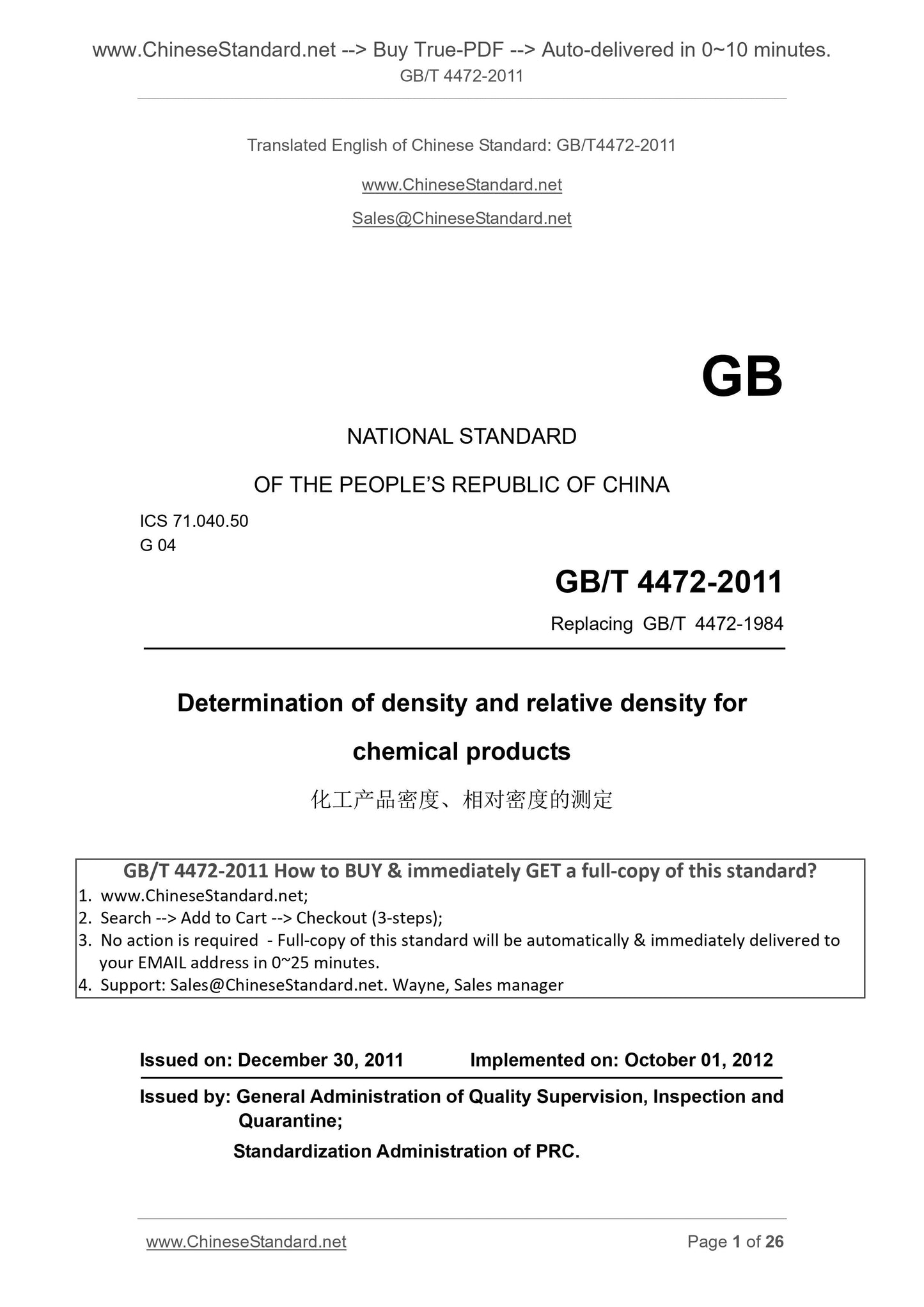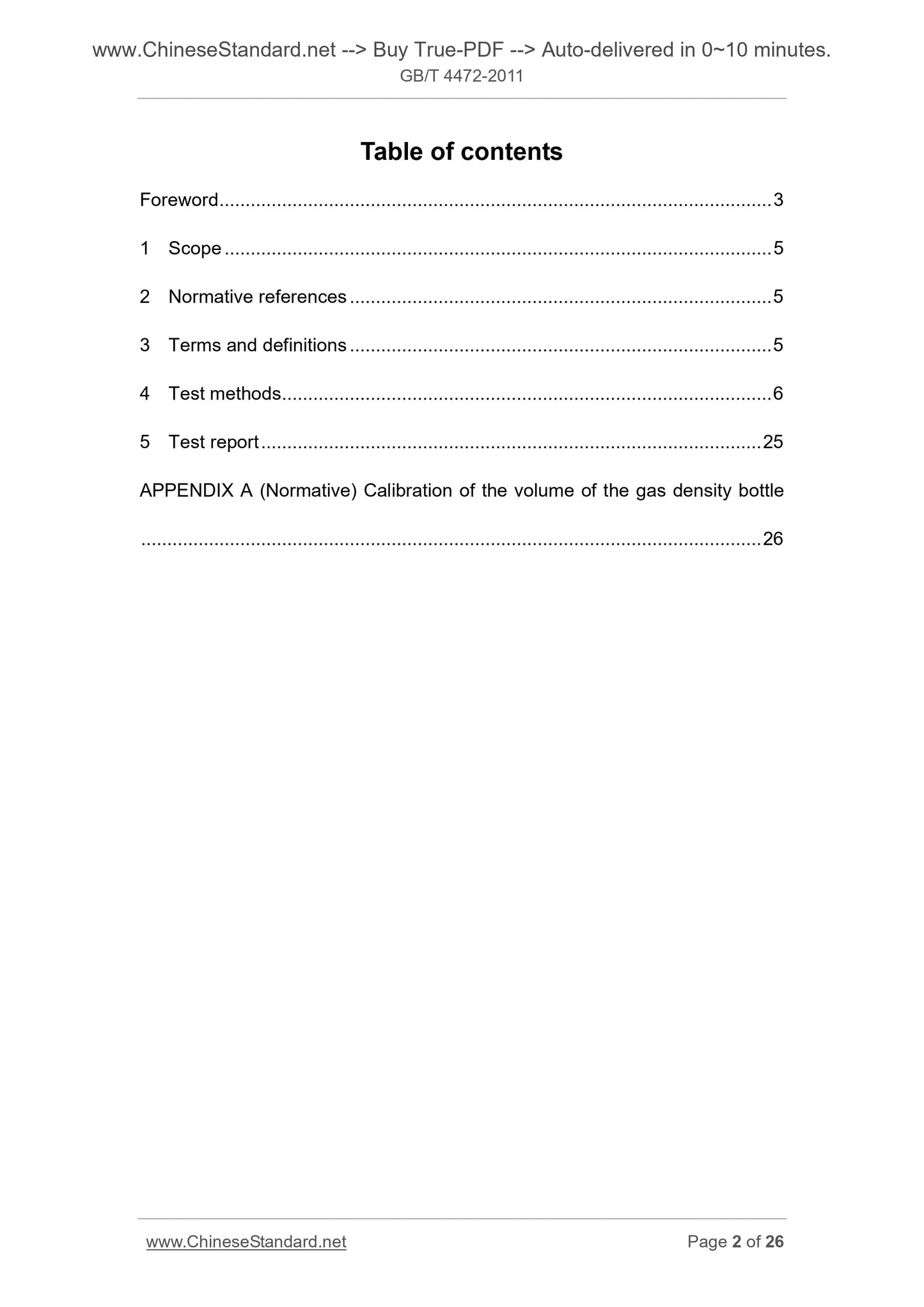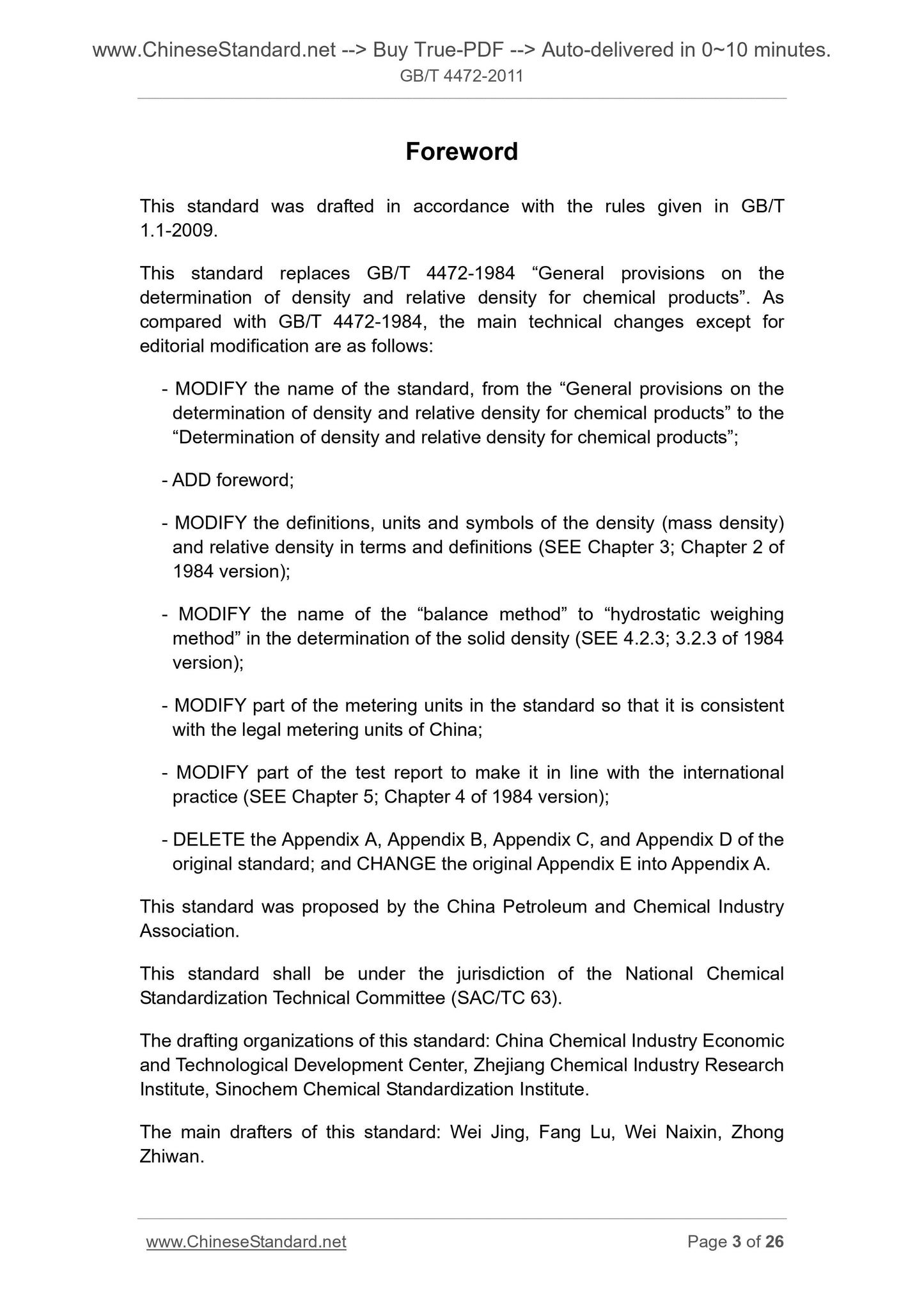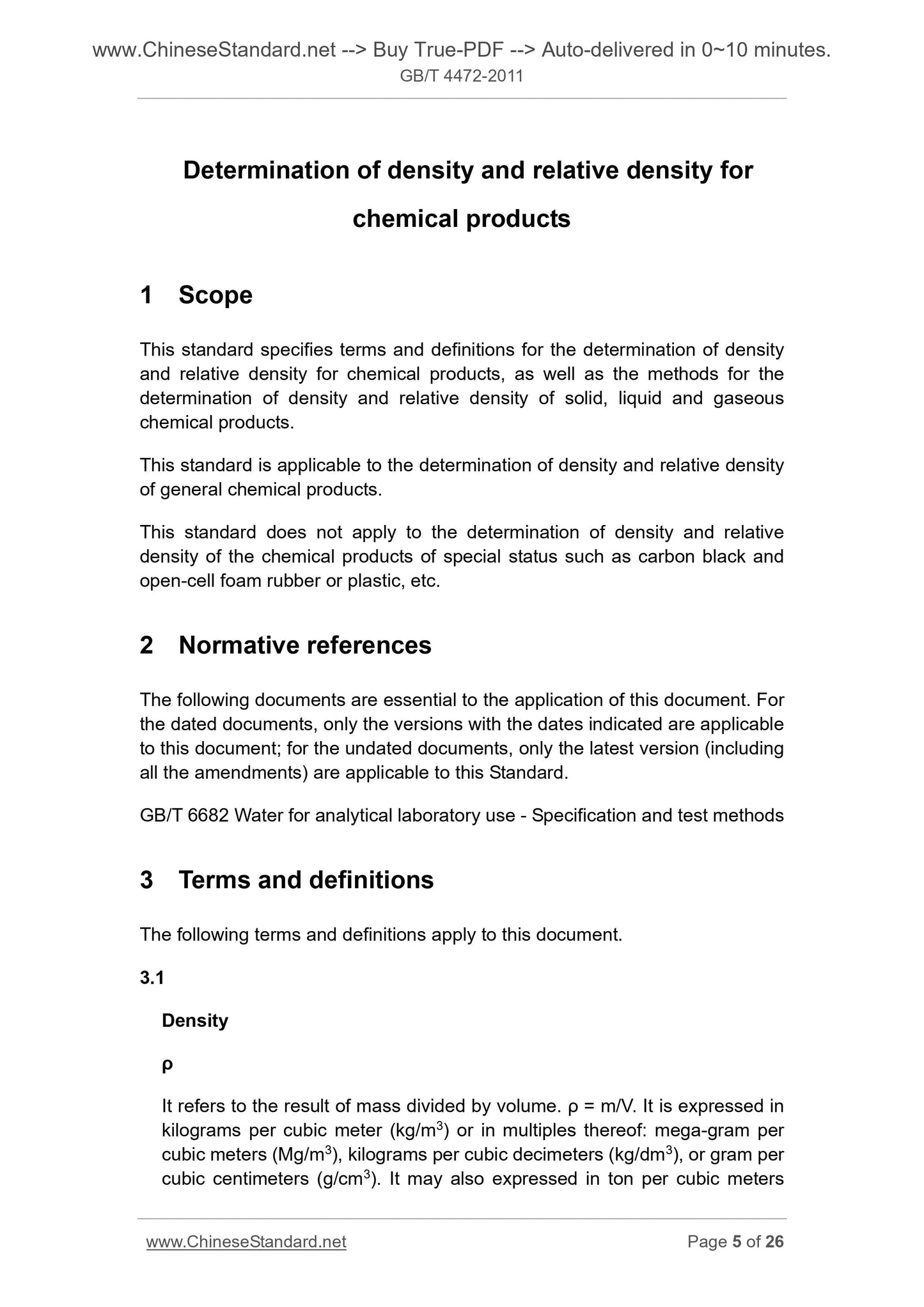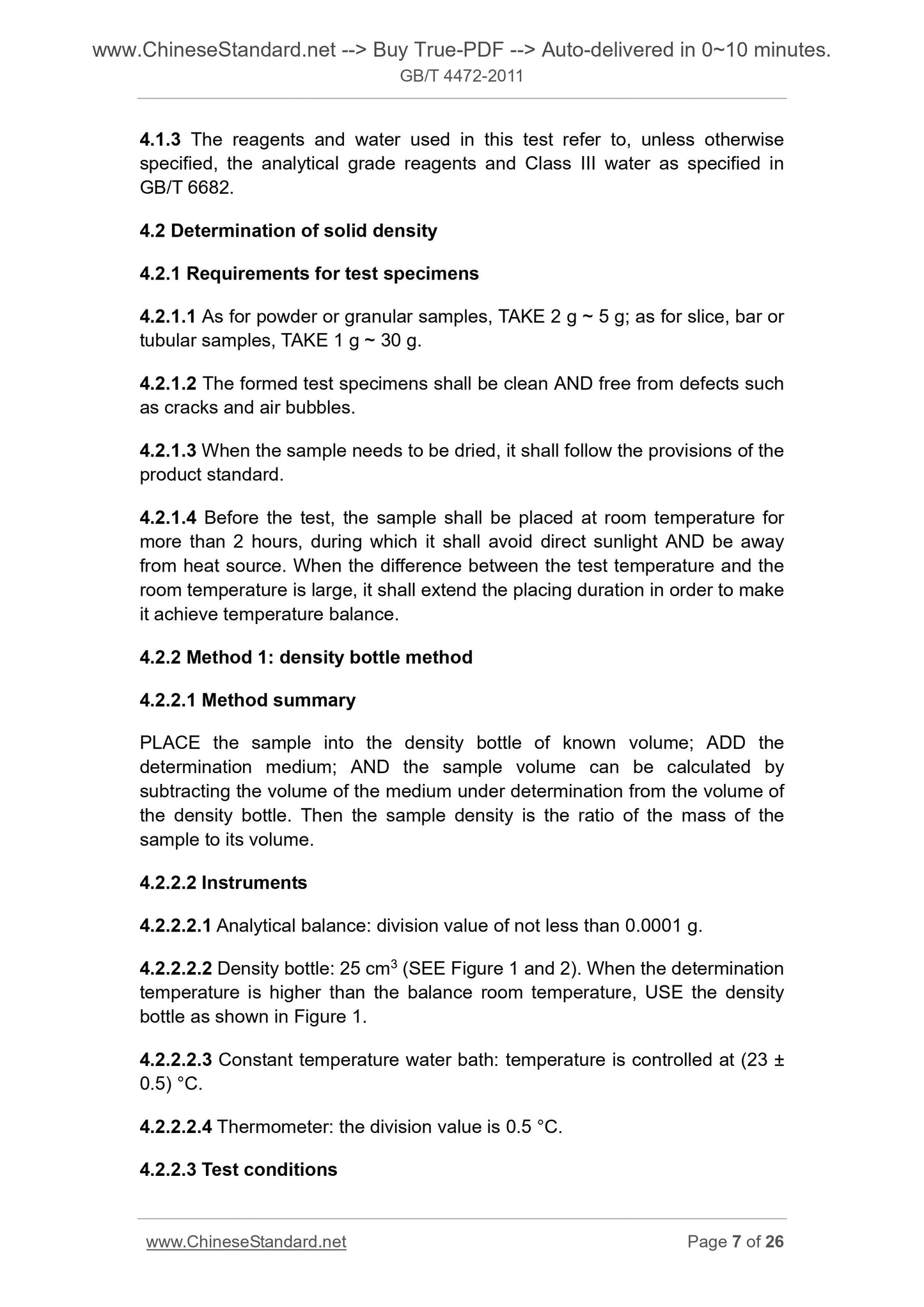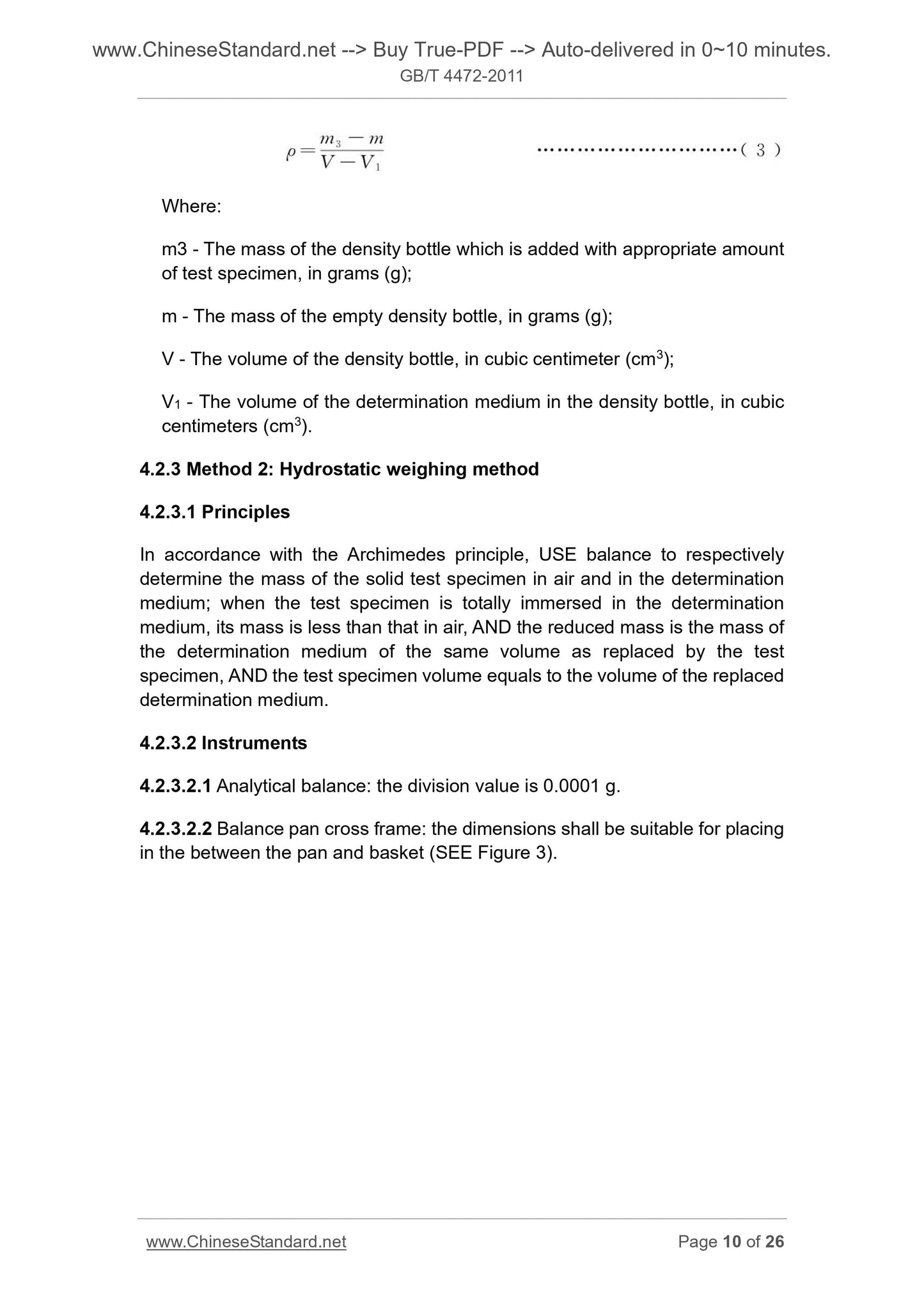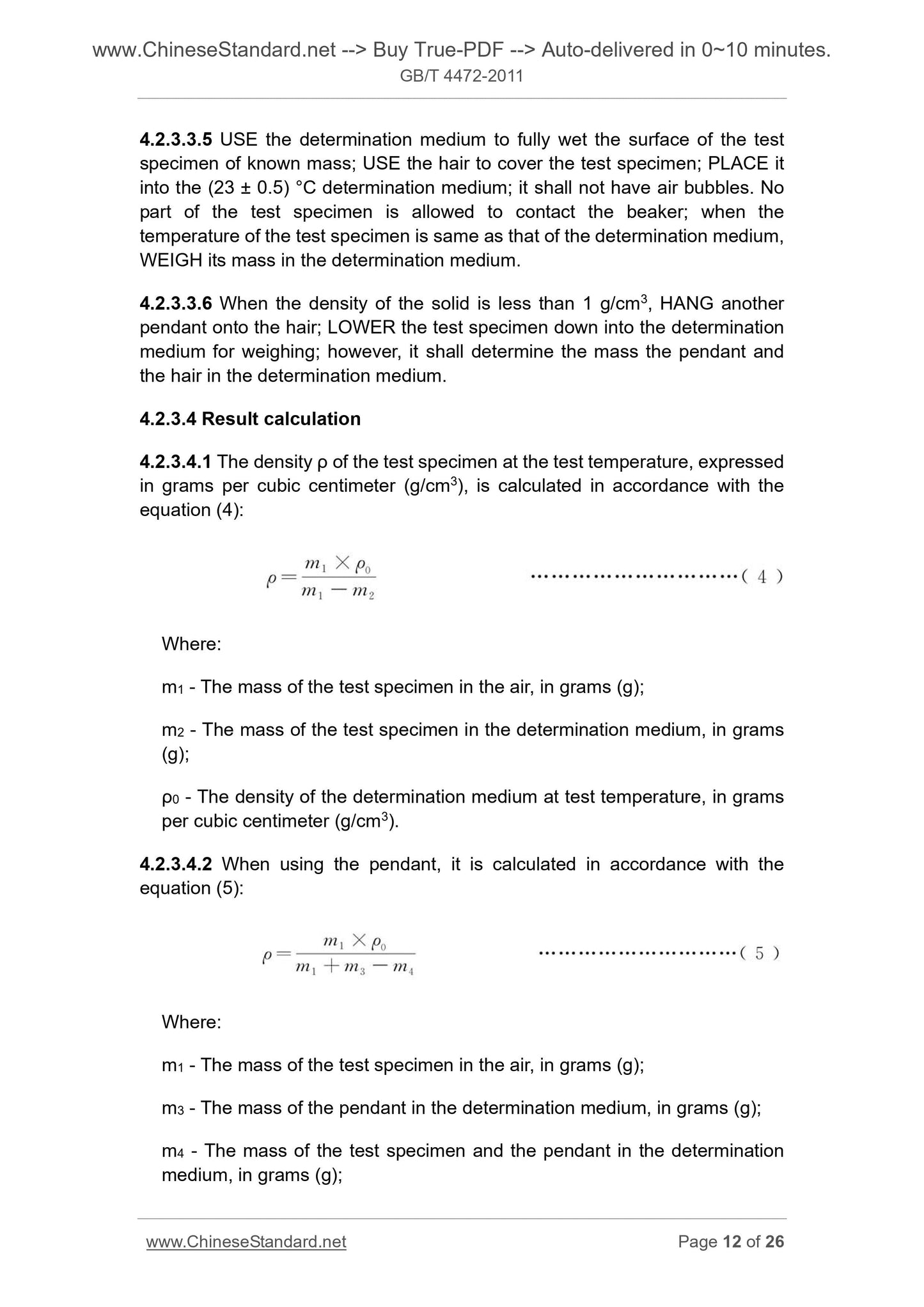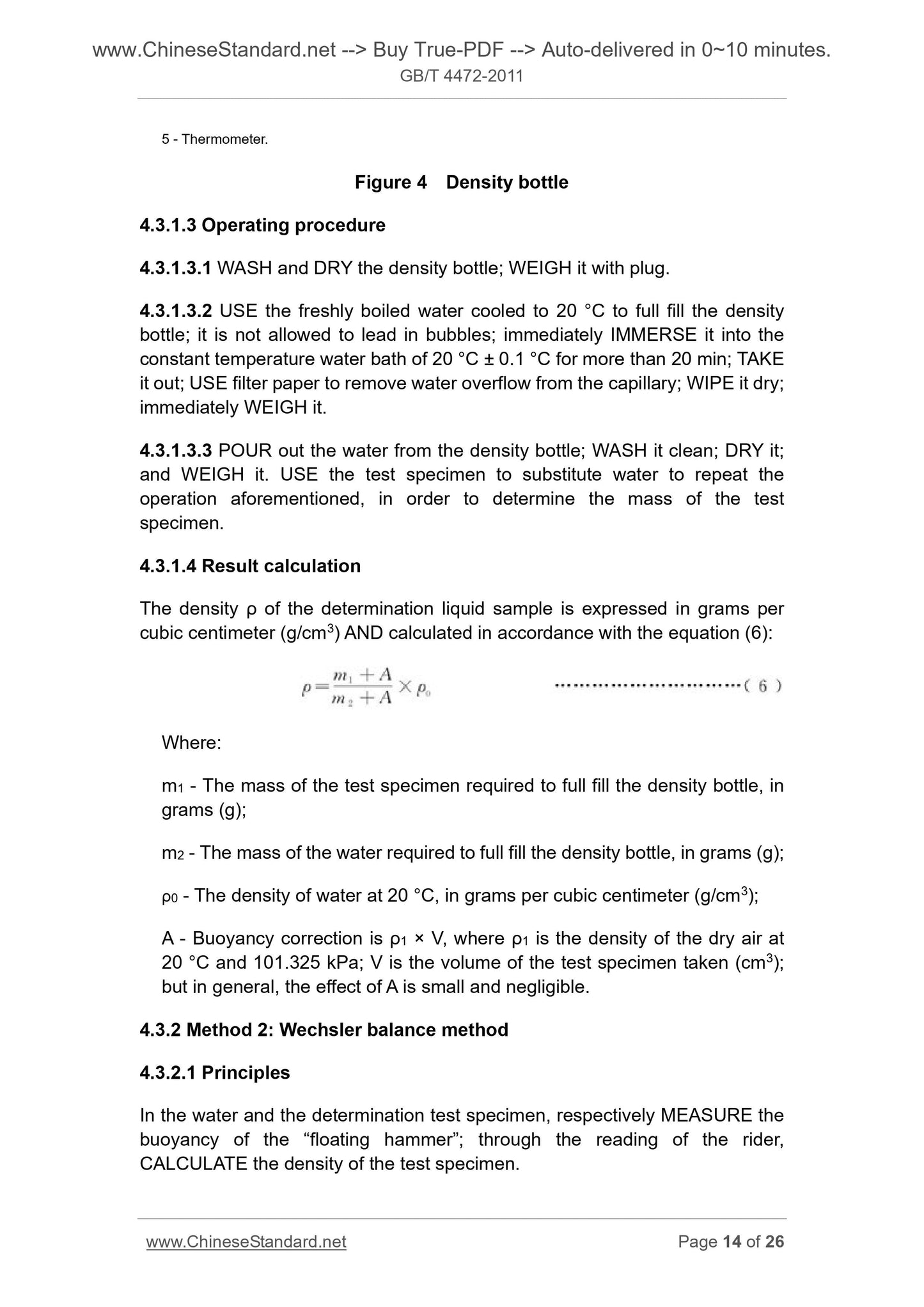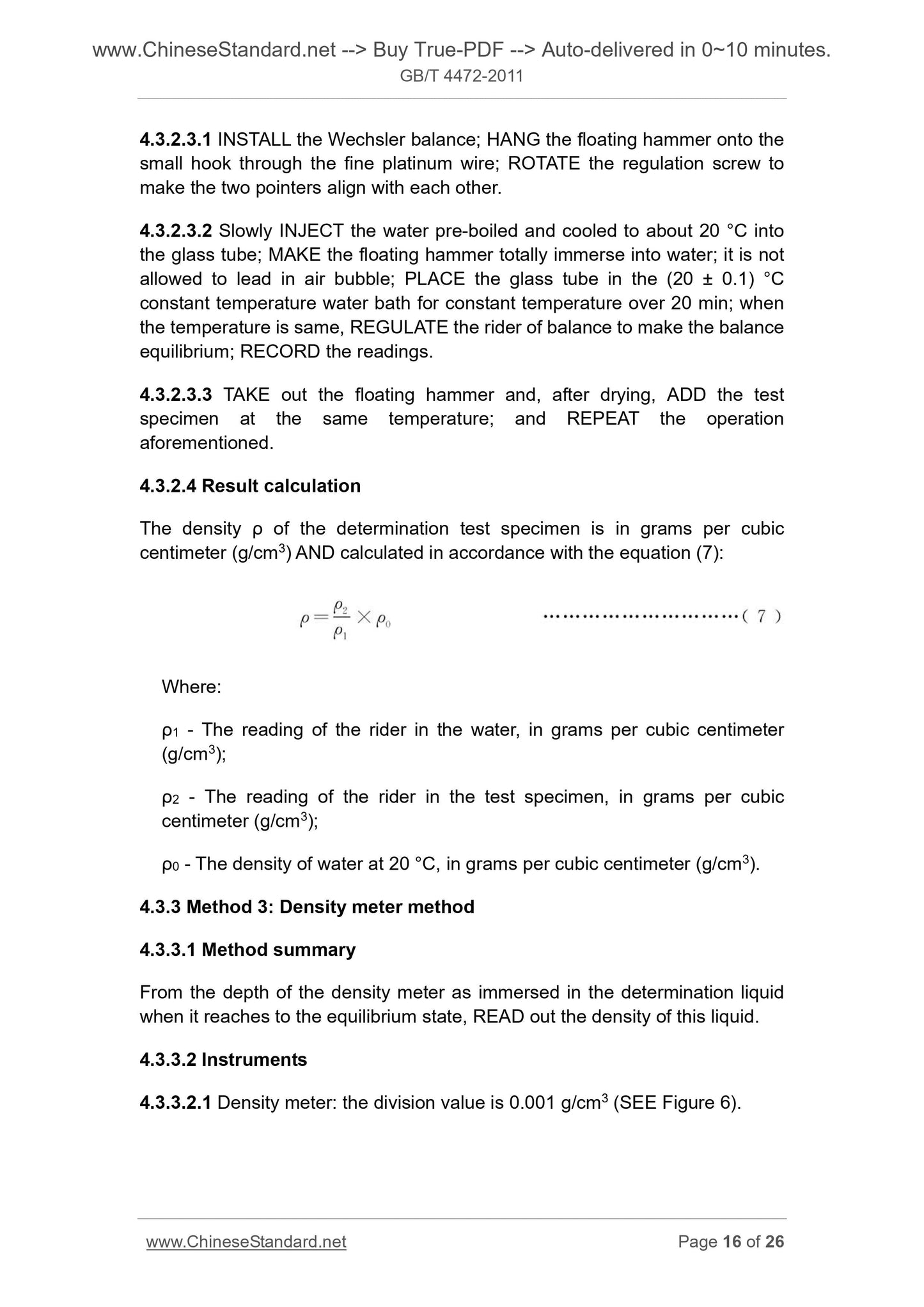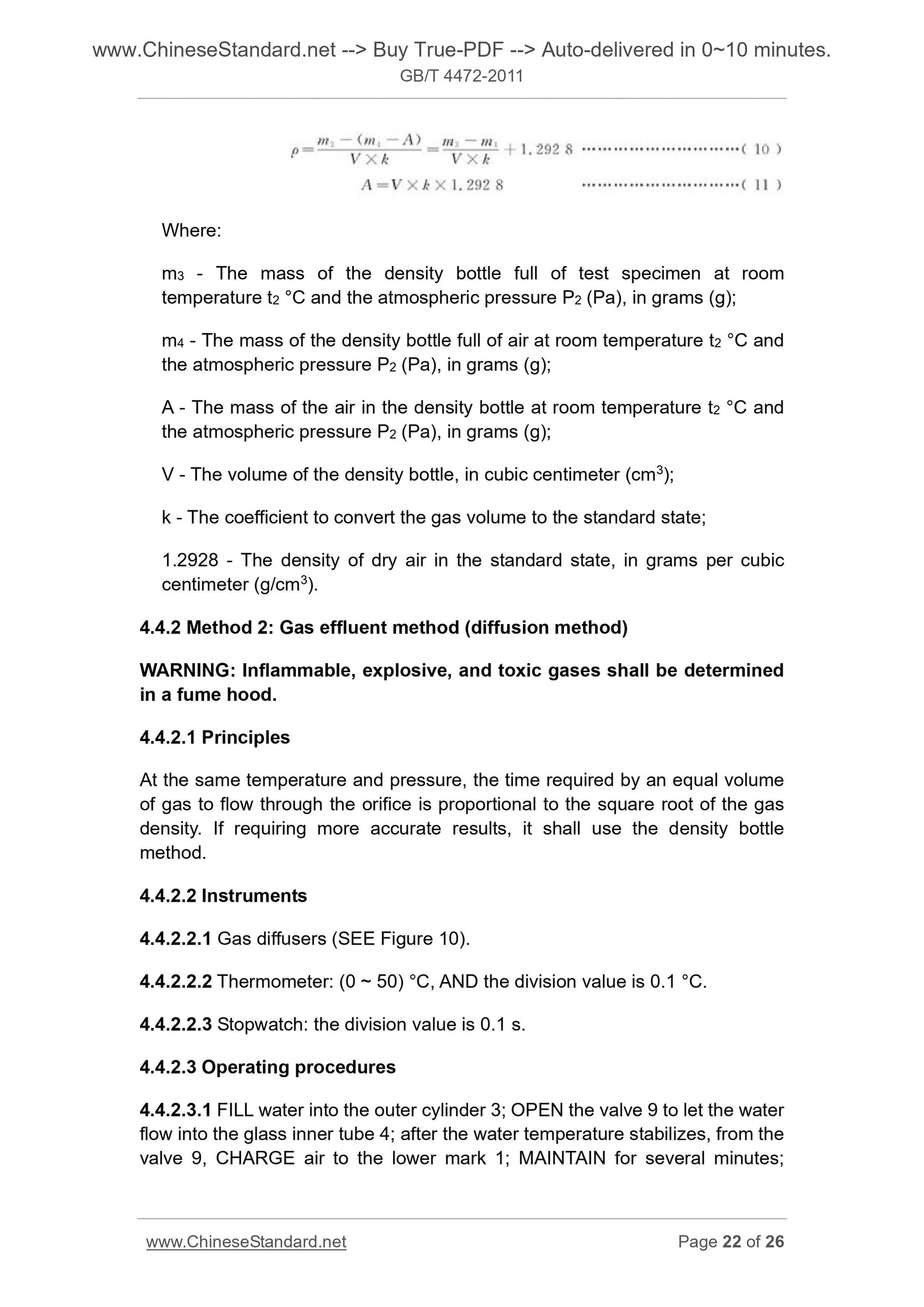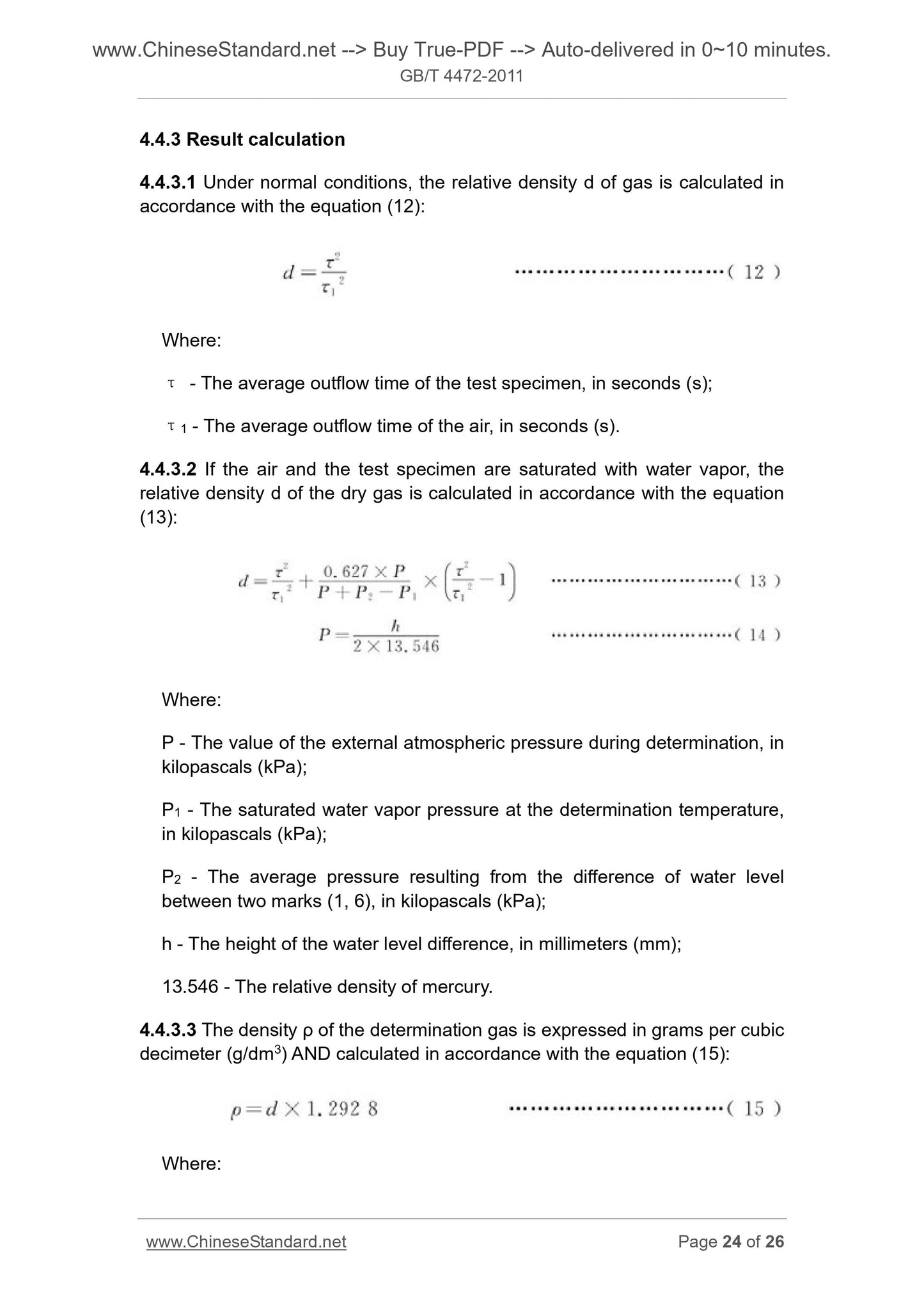1
/
of
12
www.ChineseStandard.us -- Field Test Asia Pte. Ltd.
GB/T 4472-2011 English PDF (GB/T4472-2011)
GB/T 4472-2011 English PDF (GB/T4472-2011)
Regular price
$125.00
Regular price
Sale price
$125.00
Unit price
/
per
Shipping calculated at checkout.
Couldn't load pickup availability
GB/T 4472-2011: Determination of density and relative density for chemical products
Delivery: 9 seconds. Download (& Email) true-PDF + Invoice.
Get Quotation: Click GB/T 4472-2011 (Self-service in 1-minute)
Historical versions (Master-website): GB/T 4472-2011
Preview True-PDF (Reload/Scroll-down if blank)
GB/T 4472-2011
GB
NATIONAL STANDARD
OF THE PEOPLE’S REPUBLIC OF CHINA
ICS 71.040.50
G 04
Replacing GB/T 4472-1984
Determination of density and relative density for
chemical products
ISSUED ON. DECEMBER 30, 2011
IMPLEMENTED ON. OCTOBER 01, 2012
Issued by. General Administration of Quality Supervision, Inspection and
Quarantine;
Standardization Administration of PRC.
Table of contents
Foreword ... 3
1 Scope ... 5
2 Normative references ... 5
3 Terms and definitions ... 5
4 Test methods ... 6
5 Test report ... 25
APPENDIX A (Normative) Calibration of the volume of the gas density bottle
... 26
Foreword
This standard was drafted in accordance with the rules given in GB/T
1.1-2009.
This standard replaces GB/T 4472-1984 “General provisions on the
determination of density and relative density for chemical products”. As
compared with GB/T 4472-1984, the main technical changes except for
editorial modification are as follows.
- MODIFY the name of the standard, from the “General provisions on the
determination of density and relative density for chemical products” to the
“Determination of density and relative density for chemical products”;
- ADD foreword;
- MODIFY the definitions, units and symbols of the density (mass density)
and relative density in terms and definitions (SEE Chapter 3; Chapter 2 of
1984 version);
- MODIFY the name of the “balance method” to “hydrostatic weighing
method” in the determination of the solid density (SEE 4.2.3; 3.2.3 of 1984
version);
- MODIFY part of the metering units in the standard so that it is consistent
with the legal metering units of China;
- MODIFY part of the test report to make it in line with the international
practice (SEE Chapter 5; Chapter 4 of 1984 version);
- DELETE the Appendix A, Appendix B, Appendix C, and Appendix D of the
original standard; and CHANGE the original Appendix E into Appendix A.
This standard was proposed by the China Petroleum and Chemical Industry
Association.
This standard shall be under the jurisdiction of the National Chemical
Standardization Technical Committee (SAC/TC 63).
The drafting organizations of this standard. China Chemical Industry Economic
and Technological Development Center, Zhejiang Chemical Industry Research
Institute, Sinochem Chemical Standardization Institute.
The main drafters of this standard. Wei Jing, Fang Lu, Wei Naixin, Zhong
Zhiwan.
Determination of density and relative density for
chemical products
1 Scope
This standard specifies terms and definitions for the determination of density
and relative density for chemical products, as well as the methods for the
determination of density and relative density of solid, liquid and gaseous
chemical products.
This standard is applicable to the determination of density and relative density
of general chemical products.
This standard does not apply to the determination of density and relative
density of the chemical products of special status such as carbon black and
open-cell foam rubber or plastic, etc.
2 Normative references
The following documents are essential to the application of this document. For
the dated documents, only the versions with the dates indicated are applicable
to this document; for the undated documents, only the latest version (including
all the amendments) are applicable to this Standard.
GB/T 6682 Water for analytical laboratory use - Specification and test methods
3 Terms and definitions
The following terms and definitions apply to this document.
3.1
Density
It refers to the result of mass divided by volume. ρ = m/V. It is expressed in
kilograms per cubic meter (kg/m3) or in multiples thereof. mega-gram per
cubic meters (Mg/m3), kilograms per cubic decimeters (kg/dm3), or gram per
cubic centimeters (g/cm3). It may also expressed in ton per cubic meters
4.1.3 The reagents and water used in this test refer to, unless otherwise
specified, the analytical grade reagents and Class III water as specified in
GB/T 6682.
4.2 Determination of solid density
4.2.1 Requirements for test specimens
4.2.1.1 As for powder or granular samples, TAKE 2 g ~ 5 g; as for slice, bar or
tubular samples, TAKE 1 g ~ 30 g.
4.2.1.2 The formed test specimens shall be clean AND free from defects such
as cracks and air bubbles.
4.2.1.3 When the sample needs to be dried, it shall follow the provisions of the
product standard.
4.2.1.4 Before the test, the sample shall be placed at room temperature for
more than 2 hours, during which it shall avoid direct sunlight AND be away
from heat source. When the difference between the test temperature and the
room temperature is large, it shall extend the placing duration in order to make
it achieve temperature balance.
4.2.2 Method 1. density bottle method
4.2.2.1 Method summary
PLACE the sample into the density bottle of known volume; ADD the
determination medium; AND the sample volume can be calculated by
subtracting the volume of the medium under determination from the volume of
the density bottle. Then the sample density is the ratio of the mass of the
sample to its volume.
4.2.2.2 Instruments
4.2.2.2.1 Analytical balance. division value of not less than 0.0001 g.
4.2.2.2.2 Density bottle. 25 cm3 (SEE Figure 1 and 2). When the determination
temperature is higher than the balance room temperature, USE the density
bottle as shown in Figure 1.
4.2.2.2.3 Constant temperature water bath. temperature is controlled at (23 ±
0.5) °C.
4.2.2.2.4 Thermometer. the division value is 0.5 °C.
4.2.2.3 Test conditions
Where.
m3 - The mass of the density bottle which is added with appropriate amount
of test specimen, in grams (g);
m - The mass of the empty density bottle, in grams (g);
V - The volume of the density bottle, in cubic centimeter (cm3);
V1 - The volume of the determination medium in the density bottle, in cubic
centimeters (cm3).
4.2.3 Method 2. Hydrostatic weighing method
4.2.3.1 Principles
In accordance with the Archimedes principle, USE balance to respectively
determine the mass of the solid test specimen in air and in the determination
medium; when the test specimen is totally immersed in the determination
medium, its mass is less than that in air, AND the reduced mass is the mass of
the determination medium of the same volume as replaced by the test
specimen, AND the test specimen volume equals to the volume of the replaced
determination medium.
4.2.3.2 Instruments
4.2.3.2.1 Analytical balance. the division value is 0.0001 g.
4.2.3.2.2 Balance pan cross frame. the dimensions shall be suitable for placing
in the between the pan and basket (SEE Figure 3).
4.2.3.3.5 USE the determination medium to fully wet the surface of the test
specimen of known mass; USE the hair to cover the test specimen; PLACE it
into the (23 ± 0.5) °C determination medium; it shall not have air bubbles. No
part of the test specimen is allowed to contact the beaker; when the
temperature of the test specimen is same as that of the determination medium,
WEIGH its mass in the determination medium.
4.2.3.3.6 When the density of the solid is less than 1 g/cm3, HANG another
pendant onto the hair; LOWER the test specimen down into the determination
medium for weighing; however, it shall determine the mass the pendant and
the hair in the determination medium.
4.2.3.4 Result calculation
4.2.3.4.1 The density ρ of the test specimen at the test temperature, expressed
in grams per cubic centimeter (g/cm3), is calculated in accordance with the
equation (4).
Where.
m1 - The mass of the test specimen in the air, in grams (g);
m2 - The mass of the test specimen in the determination medium, in grams
(g);
ρ0 - The density of the determination medium at test temperature, in grams
per cubic centimeter (g/cm3).
4.2.3.4.2 When using the pendant, it is calculated in accordance with the
equation (5).
Where.
m1 - The mass of the test specimen in the air, in grams (g);
m3 - The mass of the pendant in the determination medium, in grams (g);
m4 - The mass of the test specimen and the pendant in the determination
medium, in grams (g);
5 - Thermometer.
Figure 4 Density bottle
4.3.1.3 Operating procedure
4.3.1.3.1 WASH and DRY the density bottle; WEIGH it with plug.
4.3.1.3.2 USE the freshly boiled water cooled to 20 °C to full fill the density
bottle; it is not allowed to lead in bubbles; immediately IMMERSE it into the
constant temperature water bath of 20 °C ± 0.1 °C for more than 20 min; TAKE
it out; USE filter paper to remove water overflow from the capillary; WIPE it dry;
immediately WEIGH it.
4.3.1.3.3 POUR out the water from the density bottle; WASH it clean; DRY it;
and WEIGH it. USE the test specimen to substitute water to repeat the
operation aforementioned, in order to determine the mass of the test
specimen.
4.3.1.4 Result calculation
The density ρ of the determination liquid sample is expressed in grams per
cubic centimeter (g/cm3) AND calculated in accordance with the equation (6).
Where.
m1 - The mass of the test specimen required to full fill the density bottle, in
...
GB/T 4472-2011
GB
NATIONAL STANDARD
OF THE PEOPLE’S REPUBLIC OF CHINA
ICS 71.040.50
G 04
Replacing GB/T 4472-1984
Determination of density and relative density for
chemical products
ISSUED ON. DECEMBER 30, 2011
IMPLEMENTED ON. OCTOBER 01, 2012
Issued by. General Administration of Quality Supervision, Inspection and
Quarantine;
Standardization Administration of PRC.
Table of contents
Foreword ... 3
1 Scope ... 5
2 Normative references ... 5
3 Terms and definitions ... 5
4 Test methods ... 6
5 Test report ... 25
APPENDIX A (Normative) Calibration of the volume of the gas density bottle
... 26
Foreword
This standard was drafted in accordance with the rules given in GB/T
1.1-2009.
This standard replaces GB/T 4472-1984 “General provisions on the
determination of density and relative density for chemical products”. As
compared with GB/T 4472-1984, the main technical changes except for
editorial modification are as follows.
- MODIFY the name of the standard, from the “General provisions on the
determination of density and relative density for chemical products” to the
“Determination of density and relative density for chemical products”;
- ADD foreword;
- MODIFY the definitions, units and symbols of the density (mass density)
and relative density in terms and definitions (SEE Chapter 3; Chapter 2 of
1984 version);
- MODIFY the name of the “balance method” to “hydrostatic weighing
method” in the determination of the solid density (SEE 4.2.3; 3.2.3 of 1984
version);
- MODIFY part of the metering units in the standard so that it is consistent
with the legal metering units of China;
- MODIFY part of the test report to make it in line with the international
practice (SEE Chapter 5; Chapter 4 of 1984 version);
- DELETE the Appendix A, Appendix B, Appendix C, and Appendix D of the
original standard; and CHANGE the original Appendix E into Appendix A.
This standard was proposed by the China Petroleum and Chemical Industry
Association.
This standard shall be under the jurisdiction of the National Chemical
Standardization Technical Committee (SAC/TC 63).
The drafting organizations of this standard. China Chemical Industry Economic
and Technological Development Center, Zhejiang Chemical Industry Research
Institute, Sinochem Chemical Standardization Institute.
The main drafters of this standard. Wei Jing, Fang Lu, Wei Naixin, Zhong
Zhiwan.
Determination of density and relative density for
chemical products
1 Scope
This standard specifies terms and definitions for the determination of density
and relative density for chemical products, as well as the methods for the
determination of density and relative density of solid, liquid and gaseous
chemical products.
This standard is applicable to the determination of density and relative density
of general chemical products.
This standard does not apply to the determination of density and relative
density of the chemical products of special status such as carbon black and
open-cell foam rubber or plastic, etc.
2 Normative references
The following documents are essential to the application of this document. For
the dated documents, only the versions with the dates indicated are applicable
to this document; for the undated documents, only the latest version (including
all the amendments) are applicable to this Standard.
GB/T 6682 Water for analytical laboratory use - Specification and test methods
3 Terms and definitions
The following terms and definitions apply to this document.
3.1
Density
It refers to the result of mass divided by volume. ρ = m/V. It is expressed in
kilograms per cubic meter (kg/m3) or in multiples thereof. mega-gram per
cubic meters (Mg/m3), kilograms per cubic decimeters (kg/dm3), or gram per
cubic centimeters (g/cm3). It may also expressed in ton per cubic meters
4.1.3 The reagents and water used in this test refer to, unless otherwise
specified, the analytical grade reagents and Class III water as specified in
GB/T 6682.
4.2 Determination of solid density
4.2.1 Requirements for test specimens
4.2.1.1 As for powder or granular samples, TAKE 2 g ~ 5 g; as for slice, bar or
tubular samples, TAKE 1 g ~ 30 g.
4.2.1.2 The formed test specimens shall be clean AND free from defects such
as cracks and air bubbles.
4.2.1.3 When the sample needs to be dried, it shall follow the provisions of the
product standard.
4.2.1.4 Before the test, the sample shall be placed at room temperature for
more than 2 hours, during which it shall avoid direct sunlight AND be away
from heat source. When the difference between the test temperature and the
room temperature is large, it shall extend the placing duration in order to make
it achieve tempe...
Delivery: 9 seconds. Download (& Email) true-PDF + Invoice.
Get Quotation: Click GB/T 4472-2011 (Self-service in 1-minute)
Historical versions (Master-website): GB/T 4472-2011
Preview True-PDF (Reload/Scroll-down if blank)
GB/T 4472-2011
GB
NATIONAL STANDARD
OF THE PEOPLE’S REPUBLIC OF CHINA
ICS 71.040.50
G 04
Replacing GB/T 4472-1984
Determination of density and relative density for
chemical products
ISSUED ON. DECEMBER 30, 2011
IMPLEMENTED ON. OCTOBER 01, 2012
Issued by. General Administration of Quality Supervision, Inspection and
Quarantine;
Standardization Administration of PRC.
Table of contents
Foreword ... 3
1 Scope ... 5
2 Normative references ... 5
3 Terms and definitions ... 5
4 Test methods ... 6
5 Test report ... 25
APPENDIX A (Normative) Calibration of the volume of the gas density bottle
... 26
Foreword
This standard was drafted in accordance with the rules given in GB/T
1.1-2009.
This standard replaces GB/T 4472-1984 “General provisions on the
determination of density and relative density for chemical products”. As
compared with GB/T 4472-1984, the main technical changes except for
editorial modification are as follows.
- MODIFY the name of the standard, from the “General provisions on the
determination of density and relative density for chemical products” to the
“Determination of density and relative density for chemical products”;
- ADD foreword;
- MODIFY the definitions, units and symbols of the density (mass density)
and relative density in terms and definitions (SEE Chapter 3; Chapter 2 of
1984 version);
- MODIFY the name of the “balance method” to “hydrostatic weighing
method” in the determination of the solid density (SEE 4.2.3; 3.2.3 of 1984
version);
- MODIFY part of the metering units in the standard so that it is consistent
with the legal metering units of China;
- MODIFY part of the test report to make it in line with the international
practice (SEE Chapter 5; Chapter 4 of 1984 version);
- DELETE the Appendix A, Appendix B, Appendix C, and Appendix D of the
original standard; and CHANGE the original Appendix E into Appendix A.
This standard was proposed by the China Petroleum and Chemical Industry
Association.
This standard shall be under the jurisdiction of the National Chemical
Standardization Technical Committee (SAC/TC 63).
The drafting organizations of this standard. China Chemical Industry Economic
and Technological Development Center, Zhejiang Chemical Industry Research
Institute, Sinochem Chemical Standardization Institute.
The main drafters of this standard. Wei Jing, Fang Lu, Wei Naixin, Zhong
Zhiwan.
Determination of density and relative density for
chemical products
1 Scope
This standard specifies terms and definitions for the determination of density
and relative density for chemical products, as well as the methods for the
determination of density and relative density of solid, liquid and gaseous
chemical products.
This standard is applicable to the determination of density and relative density
of general chemical products.
This standard does not apply to the determination of density and relative
density of the chemical products of special status such as carbon black and
open-cell foam rubber or plastic, etc.
2 Normative references
The following documents are essential to the application of this document. For
the dated documents, only the versions with the dates indicated are applicable
to this document; for the undated documents, only the latest version (including
all the amendments) are applicable to this Standard.
GB/T 6682 Water for analytical laboratory use - Specification and test methods
3 Terms and definitions
The following terms and definitions apply to this document.
3.1
Density
It refers to the result of mass divided by volume. ρ = m/V. It is expressed in
kilograms per cubic meter (kg/m3) or in multiples thereof. mega-gram per
cubic meters (Mg/m3), kilograms per cubic decimeters (kg/dm3), or gram per
cubic centimeters (g/cm3). It may also expressed in ton per cubic meters
4.1.3 The reagents and water used in this test refer to, unless otherwise
specified, the analytical grade reagents and Class III water as specified in
GB/T 6682.
4.2 Determination of solid density
4.2.1 Requirements for test specimens
4.2.1.1 As for powder or granular samples, TAKE 2 g ~ 5 g; as for slice, bar or
tubular samples, TAKE 1 g ~ 30 g.
4.2.1.2 The formed test specimens shall be clean AND free from defects such
as cracks and air bubbles.
4.2.1.3 When the sample needs to be dried, it shall follow the provisions of the
product standard.
4.2.1.4 Before the test, the sample shall be placed at room temperature for
more than 2 hours, during which it shall avoid direct sunlight AND be away
from heat source. When the difference between the test temperature and the
room temperature is large, it shall extend the placing duration in order to make
it achieve temperature balance.
4.2.2 Method 1. density bottle method
4.2.2.1 Method summary
PLACE the sample into the density bottle of known volume; ADD the
determination medium; AND the sample volume can be calculated by
subtracting the volume of the medium under determination from the volume of
the density bottle. Then the sample density is the ratio of the mass of the
sample to its volume.
4.2.2.2 Instruments
4.2.2.2.1 Analytical balance. division value of not less than 0.0001 g.
4.2.2.2.2 Density bottle. 25 cm3 (SEE Figure 1 and 2). When the determination
temperature is higher than the balance room temperature, USE the density
bottle as shown in Figure 1.
4.2.2.2.3 Constant temperature water bath. temperature is controlled at (23 ±
0.5) °C.
4.2.2.2.4 Thermometer. the division value is 0.5 °C.
4.2.2.3 Test conditions
Where.
m3 - The mass of the density bottle which is added with appropriate amount
of test specimen, in grams (g);
m - The mass of the empty density bottle, in grams (g);
V - The volume of the density bottle, in cubic centimeter (cm3);
V1 - The volume of the determination medium in the density bottle, in cubic
centimeters (cm3).
4.2.3 Method 2. Hydrostatic weighing method
4.2.3.1 Principles
In accordance with the Archimedes principle, USE balance to respectively
determine the mass of the solid test specimen in air and in the determination
medium; when the test specimen is totally immersed in the determination
medium, its mass is less than that in air, AND the reduced mass is the mass of
the determination medium of the same volume as replaced by the test
specimen, AND the test specimen volume equals to the volume of the replaced
determination medium.
4.2.3.2 Instruments
4.2.3.2.1 Analytical balance. the division value is 0.0001 g.
4.2.3.2.2 Balance pan cross frame. the dimensions shall be suitable for placing
in the between the pan and basket (SEE Figure 3).
4.2.3.3.5 USE the determination medium to fully wet the surface of the test
specimen of known mass; USE the hair to cover the test specimen; PLACE it
into the (23 ± 0.5) °C determination medium; it shall not have air bubbles. No
part of the test specimen is allowed to contact the beaker; when the
temperature of the test specimen is same as that of the determination medium,
WEIGH its mass in the determination medium.
4.2.3.3.6 When the density of the solid is less than 1 g/cm3, HANG another
pendant onto the hair; LOWER the test specimen down into the determination
medium for weighing; however, it shall determine the mass the pendant and
the hair in the determination medium.
4.2.3.4 Result calculation
4.2.3.4.1 The density ρ of the test specimen at the test temperature, expressed
in grams per cubic centimeter (g/cm3), is calculated in accordance with the
equation (4).
Where.
m1 - The mass of the test specimen in the air, in grams (g);
m2 - The mass of the test specimen in the determination medium, in grams
(g);
ρ0 - The density of the determination medium at test temperature, in grams
per cubic centimeter (g/cm3).
4.2.3.4.2 When using the pendant, it is calculated in accordance with the
equation (5).
Where.
m1 - The mass of the test specimen in the air, in grams (g);
m3 - The mass of the pendant in the determination medium, in grams (g);
m4 - The mass of the test specimen and the pendant in the determination
medium, in grams (g);
5 - Thermometer.
Figure 4 Density bottle
4.3.1.3 Operating procedure
4.3.1.3.1 WASH and DRY the density bottle; WEIGH it with plug.
4.3.1.3.2 USE the freshly boiled water cooled to 20 °C to full fill the density
bottle; it is not allowed to lead in bubbles; immediately IMMERSE it into the
constant temperature water bath of 20 °C ± 0.1 °C for more than 20 min; TAKE
it out; USE filter paper to remove water overflow from the capillary; WIPE it dry;
immediately WEIGH it.
4.3.1.3.3 POUR out the water from the density bottle; WASH it clean; DRY it;
and WEIGH it. USE the test specimen to substitute water to repeat the
operation aforementioned, in order to determine the mass of the test
specimen.
4.3.1.4 Result calculation
The density ρ of the determination liquid sample is expressed in grams per
cubic centimeter (g/cm3) AND calculated in accordance with the equation (6).
Where.
m1 - The mass of the test specimen required to full fill the density bottle, in
...
GB/T 4472-2011
GB
NATIONAL STANDARD
OF THE PEOPLE’S REPUBLIC OF CHINA
ICS 71.040.50
G 04
Replacing GB/T 4472-1984
Determination of density and relative density for
chemical products
ISSUED ON. DECEMBER 30, 2011
IMPLEMENTED ON. OCTOBER 01, 2012
Issued by. General Administration of Quality Supervision, Inspection and
Quarantine;
Standardization Administration of PRC.
Table of contents
Foreword ... 3
1 Scope ... 5
2 Normative references ... 5
3 Terms and definitions ... 5
4 Test methods ... 6
5 Test report ... 25
APPENDIX A (Normative) Calibration of the volume of the gas density bottle
... 26
Foreword
This standard was drafted in accordance with the rules given in GB/T
1.1-2009.
This standard replaces GB/T 4472-1984 “General provisions on the
determination of density and relative density for chemical products”. As
compared with GB/T 4472-1984, the main technical changes except for
editorial modification are as follows.
- MODIFY the name of the standard, from the “General provisions on the
determination of density and relative density for chemical products” to the
“Determination of density and relative density for chemical products”;
- ADD foreword;
- MODIFY the definitions, units and symbols of the density (mass density)
and relative density in terms and definitions (SEE Chapter 3; Chapter 2 of
1984 version);
- MODIFY the name of the “balance method” to “hydrostatic weighing
method” in the determination of the solid density (SEE 4.2.3; 3.2.3 of 1984
version);
- MODIFY part of the metering units in the standard so that it is consistent
with the legal metering units of China;
- MODIFY part of the test report to make it in line with the international
practice (SEE Chapter 5; Chapter 4 of 1984 version);
- DELETE the Appendix A, Appendix B, Appendix C, and Appendix D of the
original standard; and CHANGE the original Appendix E into Appendix A.
This standard was proposed by the China Petroleum and Chemical Industry
Association.
This standard shall be under the jurisdiction of the National Chemical
Standardization Technical Committee (SAC/TC 63).
The drafting organizations of this standard. China Chemical Industry Economic
and Technological Development Center, Zhejiang Chemical Industry Research
Institute, Sinochem Chemical Standardization Institute.
The main drafters of this standard. Wei Jing, Fang Lu, Wei Naixin, Zhong
Zhiwan.
Determination of density and relative density for
chemical products
1 Scope
This standard specifies terms and definitions for the determination of density
and relative density for chemical products, as well as the methods for the
determination of density and relative density of solid, liquid and gaseous
chemical products.
This standard is applicable to the determination of density and relative density
of general chemical products.
This standard does not apply to the determination of density and relative
density of the chemical products of special status such as carbon black and
open-cell foam rubber or plastic, etc.
2 Normative references
The following documents are essential to the application of this document. For
the dated documents, only the versions with the dates indicated are applicable
to this document; for the undated documents, only the latest version (including
all the amendments) are applicable to this Standard.
GB/T 6682 Water for analytical laboratory use - Specification and test methods
3 Terms and definitions
The following terms and definitions apply to this document.
3.1
Density
It refers to the result of mass divided by volume. ρ = m/V. It is expressed in
kilograms per cubic meter (kg/m3) or in multiples thereof. mega-gram per
cubic meters (Mg/m3), kilograms per cubic decimeters (kg/dm3), or gram per
cubic centimeters (g/cm3). It may also expressed in ton per cubic meters
4.1.3 The reagents and water used in this test refer to, unless otherwise
specified, the analytical grade reagents and Class III water as specified in
GB/T 6682.
4.2 Determination of solid density
4.2.1 Requirements for test specimens
4.2.1.1 As for powder or granular samples, TAKE 2 g ~ 5 g; as for slice, bar or
tubular samples, TAKE 1 g ~ 30 g.
4.2.1.2 The formed test specimens shall be clean AND free from defects such
as cracks and air bubbles.
4.2.1.3 When the sample needs to be dried, it shall follow the provisions of the
product standard.
4.2.1.4 Before the test, the sample shall be placed at room temperature for
more than 2 hours, during which it shall avoid direct sunlight AND be away
from heat source. When the difference between the test temperature and the
room temperature is large, it shall extend the placing duration in order to make
it achieve tempe...
Share
